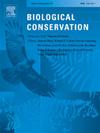结合遥感和物种特征评估农牧景观中鸟类对野火的反应
IF 4.9
1区 环境科学与生态学
Q1 BIODIVERSITY CONSERVATION
引用次数: 0
摘要
气候导致的野火增加使其成为欧洲生物多样性研究的关键优先事项。然而,利用物种特征来解释对野火的不同反应并为有针对性的保护工作提供信息的研究仍然有限。为了解决这一差距,我们在经典喀斯特(Classic Karst)的一个4450公顷的烧毁和邻近未烧毁的农牧景观中调查了野火一年后的鸟类群落,这是一个跨越意大利和斯洛文尼亚的保护区,正在减少农牧农业。利用遥感数据和机器学习技术绘制野火严重程度图,并基于139个鸟类点计数对鸟类与栖息地的关联进行精细分类。与未燃烧地区(丰富度平均值/点= 6.43 SE±0.22)相比,野火显著减少了木质生物量,鸟类物种丰富度(平均值/点= 5.09 SE±0.22)和丰度(平均值/点= 6.69 SE±0.35)也较低。丰度平均值/点= 8.71 SE±0.32)。然而,其影响因物种特征而异。火灾后发生率最低的物种是依赖植被覆盖的高灌木和森林栖息鸟类,特别是那些有开杯筑巢和树枝边缘觅食行为的鸟类。相反,洞穴筑巢者和树干/树皮觅食者更频繁地出现在被烧毁的地区,这可能是由于它们巢穴的结构弹性和火灾后腐木无脊椎动物的可用性。一些具有保护意义的半开放生境物种,特别是那些采用地面筑巢和地面觅食策略的物种,在烧毁地区的出现也有所增加。在非均匀的未燃烧灌木斑块中,更频繁地发现体型较小的物种,这与结构不连续假说相一致。居民/短距离移徙者似乎比长途移徙者受到的影响较小,这可能是由于他们全年持续或部分存在。我们的研究结果强调了基于特征和遥感分析相结合的价值,以确定野火后的物种响应,为旨在平衡地中海易火景观中开放栖息地和森林物种需求的保护策略提供重要见解。本文章由计算机程序翻译,如有差异,请以英文原文为准。
Integrating remote sensing and species' traits to assess bird responses to wildfire in agropastoral landscapes
The climate-induced increase in wildfires has made them a critical research priority for biodiversity in Europe. Yet, studies leveraging species traits to explain varying responses to wildfires and inform targeted conservation efforts remain limited. To address this gap, we surveyed bird communities one-year post-wildfire across a 4450-hectare burnt and adjacent unburnt agropastoral landscape in the Classic Karst, a protected area spanning Italy and Slovenia undergoing reductions in agropastoral farming. Remote sensing data and machine learning were employed to map wildfire severity and finely classify bird-habitat associations based on 139 bird point counts. Wildfire substantially reduced woody biomass and was associated with lower bird species richness (mean/point = 5.09 SE ± 0.22) and abundance (mean/point = 6.69 SE ± 0.35) compared to unburnt areas (richness mean/point = 6.43 SE ± 0.22; abundance mean/point = 8.71 SE ± 0.32). However, its impacts varied considerably depending on species traits. Among the species with the lowest post-fire occurrences were high shrub and forest-dwelling birds that rely on vegetation cover, particularly those with open-cup nests and branch-edge foraging behaviours. Conversely, cavity nesters and trunk/bark foragers were more frequent in burned areas, potentially due to the structural resilience of their nests and the post-fire availability of saproxylic invertebrates. Some semi-open habitat species of conservation concern, particularly those employing ground-nesting and ground-foraging strategies, also showed increased occurrence in burnt areas. Smaller-bodied species were more frequently detected in heterogeneous unburned shrub patches, consistent with the Textural Discontinuity Hypothesis. Resident/short-distance migrants appeared less affected than long-distance migrants, probably due to their continuous or partial presence year-round. Our results highlight the value of combining trait-based and remote sensing analysis to identifying species responses following wildfire, providing critical insights for conservation strategies that aim to balance the needs of both open-habitat and forest species in Mediterranean fire-prone landscapes.
求助全文
通过发布文献求助,成功后即可免费获取论文全文。
去求助
来源期刊

Biological Conservation
环境科学-环境科学
CiteScore
10.20
自引率
3.40%
发文量
295
审稿时长
61 days
期刊介绍:
Biological Conservation is an international leading journal in the discipline of conservation biology. The journal publishes articles spanning a diverse range of fields that contribute to the biological, sociological, and economic dimensions of conservation and natural resource management. The primary aim of Biological Conservation is the publication of high-quality papers that advance the science and practice of conservation, or which demonstrate the application of conservation principles for natural resource management and policy. Therefore it will be of interest to a broad international readership.
 求助内容:
求助内容: 应助结果提醒方式:
应助结果提醒方式:


